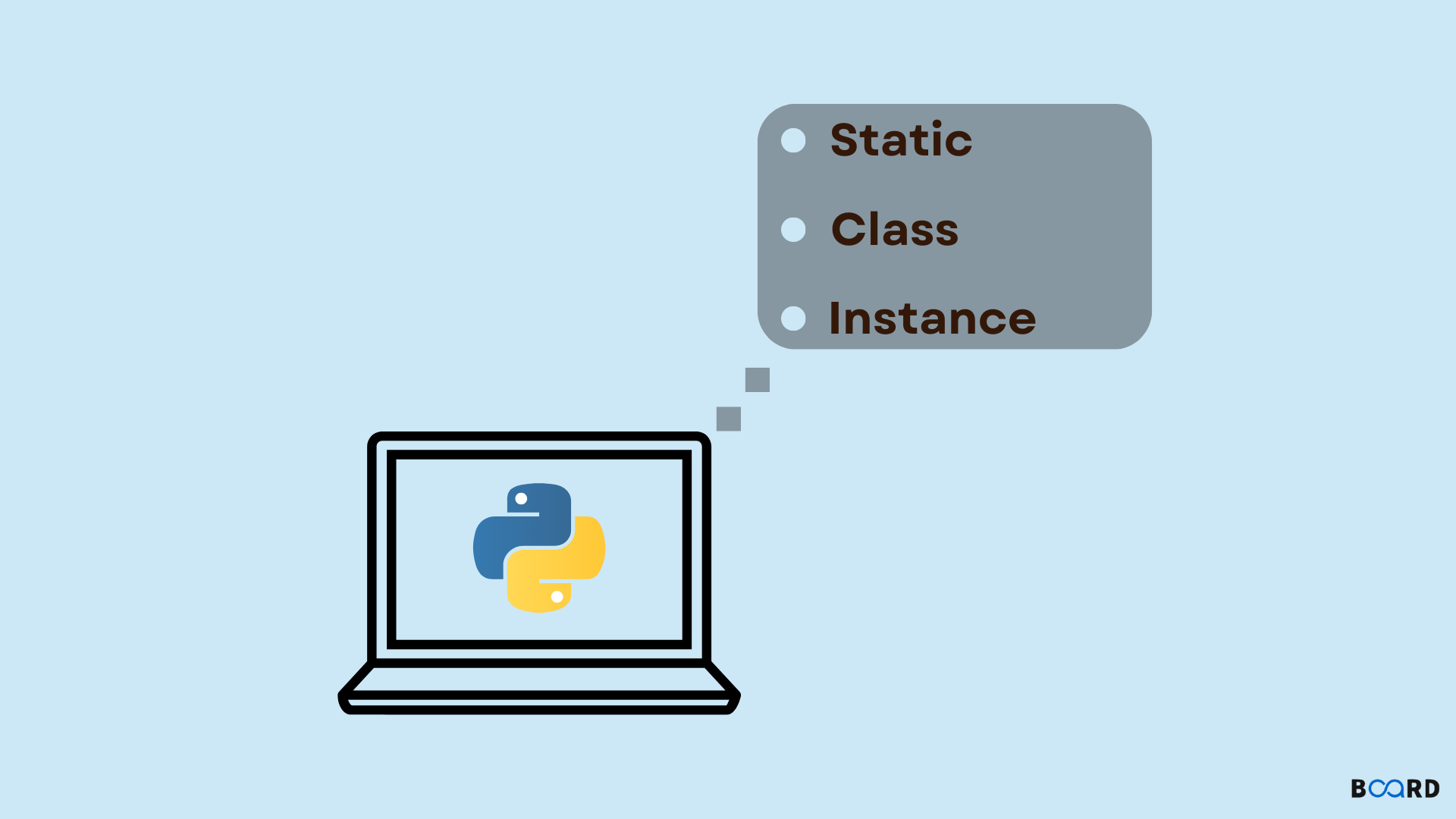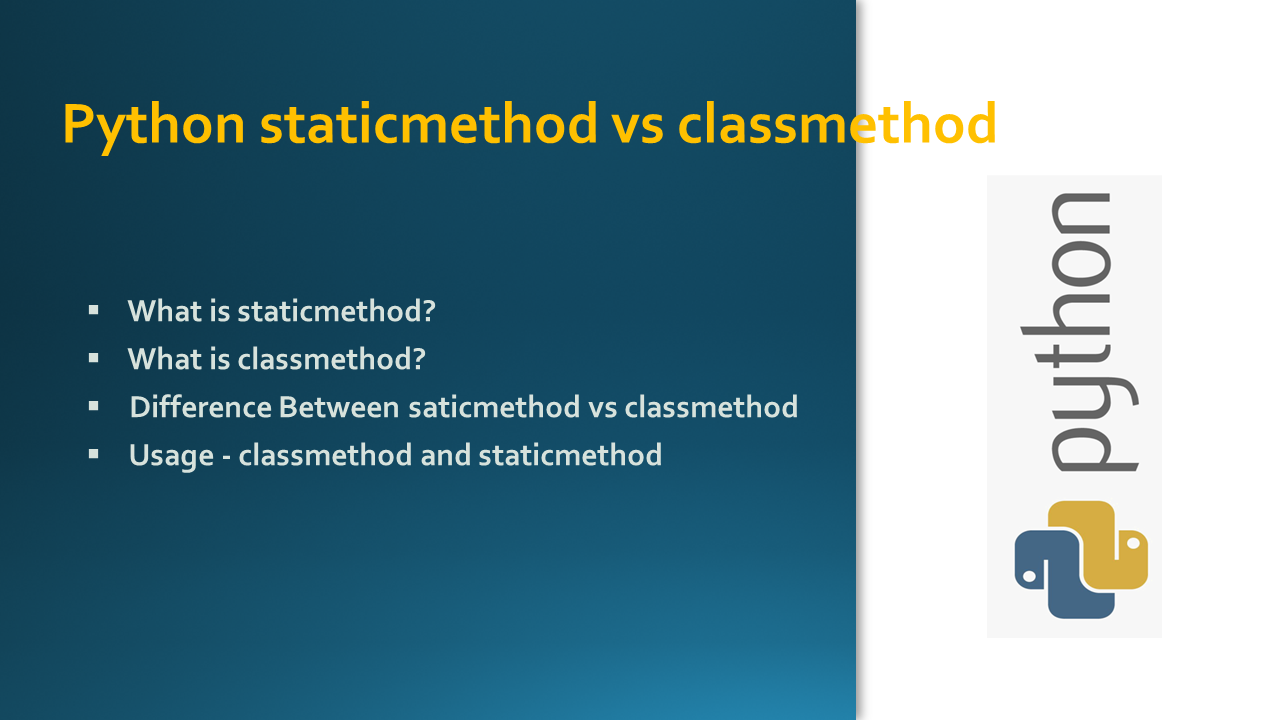Python @staticmethod vs @classmethod: Key Differences
This article explains the key differences between Python's @staticmethod and @classmethod decorators, helping you understand when to use each for more effective object-oriented programming.
This article explains the key differences between Python's @staticmethod and @classmethod decorators, helping you understand when to use each for more effective object-oriented programming.
In Python, functions defined within a class are not your typical functions. They come in three distinct types: instance methods, class methods, and static methods. Each type serves a unique purpose and interacts with the class in a specific way.
In Python, you can define functions inside a class. These aren't your regular functions, though; they come in three flavors: instance methods, class methods, and static methods.
Instance methods are the most common. They are the default when you define a function within a class. The defining characteristic of an instance method is that its first parameter is always self. This self is not just a convention; it's a reference to the instance of the class. Through self, the instance method can access and modify the object's state (its attributes).
Let's illustrate. Imagine a Dog class. An instance method could be bark(). When called on a Dog object, bark() would use self to access the dog's name (an attribute) and print "Woof! I'm [dog's name]!".
Class methods are different. They don't operate on an instance of the class but on the class itself. You mark them with the @classmethod decorator. Instead of self, their first parameter is conventionally named cls. This cls refers to the class itself.
Think of a class method like a factory for creating new Dog objects. A class method from_birth_year(cls, name, birth_year) could take the birth year as input, calculate the dog's age, and then use cls to create a new Dog object with the calculated age.
Static methods are the outsiders. They don't have access to self or cls. They are defined within a class using the @staticmethod decorator but don't interact with the class or its instances directly.
Imagine a static method is_valid_dog_name(name) within our Dog class. It would simply check if a given name meets certain criteria (like length) without caring about any specific Dog object.
So, when do you use each? Use instance methods when you need to work with the instance's data. Choose class methods for actions related to the class itself, like creating new instances in a specific way. Opt for static methods when you have a function that logically belongs within the class but doesn't need to interact with the class or its instances directly.
This Python code defines a class named Dog to represent a dog's information and actions. It includes an initialization method to set the dog's name and age, an instance method for the dog to bark, a class method to create a dog object using its birth year, and a static method to validate a dog's name. The code then demonstrates how to create dog objects, use the methods to interact with the objects, and check the validity of a dog's name.
class Dog:
"""A simple class to represent a dog."""
def __init__(self, name, age):
"""Initialize a Dog object."""
self.name = name
self.age = age
# Instance method
def bark(self):
"""Make the dog bark."""
print(f"Woof! I'm {self.name}!")
# Class method
@classmethod
def from_birth_year(cls, name, birth_year):
"""Create a Dog object from birth year."""
from datetime import date
current_year = date.today().year
age = current_year - birth_year
return cls(name, age)
# Static method
@staticmethod
def is_valid_dog_name(name):
"""Check if a name is a valid dog name (at least 2 characters)."""
return isinstance(name, str) and len(name) >= 2
# Create a Dog object
my_dog = Dog("Buddy", 3)
# Call the instance method
my_dog.bark() # Output: Woof! I'm Buddy!
# Create a Dog object using the class method
another_dog = Dog.from_birth_year("Max", 2020)
print(f"{another_dog.name} is {another_dog.age} years old.")
# Call the static method
print(Dog.is_valid_dog_name("Fido")) # Output: True
print(Dog.is_valid_dog_name("A")) # Output: FalseThis code demonstrates each type of method in action:
bark() (instance method): Accessed via a Dog object (my_dog), it uses self.name to access and print the dog's name.from_birth_year() (class method): Called on the class itself (Dog.from_birth_year()), it uses cls to create a new Dog instance after calculating the age.is_valid_dog_name() (static method): Can be called on the class (Dog.is_valid_dog_name()) and operates independently of any Dog instance.Purpose of self and cls: While self and cls are conventional names, they highlight the purpose of each parameter. You could technically name them differently, but it's highly discouraged as it makes your code less readable and breaks common Python conventions.
Inheritance: Instance methods, class methods, and static methods can all be inherited by subclasses. This means a subclass of Dog, like GoldenRetriever, would automatically have access to bark(), from_birth_year(), and is_valid_dog_name().
When to use static methods (alternative perspective): Think of static methods as functions that logically belong within the class's namespace but don't directly depend on the class or its instances. If you find yourself writing a function that operates on data closely related to your class, even without needing self or cls, it might be a good candidate for a static method.
Real-world analogy:
Flexibility: Python's method types offer flexibility in how you structure your classes and organize your code. The choice of which type to use depends on the specific relationship between the function and the class/instance.
| Function Type | Decorator | First Parameter | Purpose | Example |
|---|---|---|---|---|
| Instance Method | None (default) |
self (instance reference) |
Accesses and modifies instance attributes |
bark(): Uses self to get the dog's name and print it. |
| Class Method | @classmethod |
cls (class reference) |
Operates on the class itself, often used for object creation |
from_birth_year(cls, name, birth_year): Uses cls to create a new Dog object with calculated age. |
| Static Method | @staticmethod |
None | Logically grouped within the class but doesn't interact with it directly |
is_valid_dog_name(name): Checks name validity without needing a specific Dog object. |
Understanding the distinctions between instance methods, class methods, and static methods is crucial for writing well-structured and efficient object-oriented code in Python. By properly leveraging these method types, you can create more organized, maintainable, and powerful classes that effectively represent the relationships between your data and the actions they perform.
 Class method vs Static method in Python - GeeksforGeeks | A Computer Science portal for geeks. It contains well written, well thought and well explained computer science and programming articles, quizzes and practice/competitive programming/company interview Questions.
Class method vs Static method in Python - GeeksforGeeks | A Computer Science portal for geeks. It contains well written, well thought and well explained computer science and programming articles, quizzes and practice/competitive programming/company interview Questions. Class and Static Method in Python: Differences | Board Infinity | Python Class Method vs Static Method, a short description of Class Method vs Static Method, Syntax, including code implementation
Class and Static Method in Python: Differences | Board Infinity | Python Class Method vs Static Method, a short description of Class Method vs Static Method, Syntax, including code implementation Python staticmethod vs classmethod - Spark By {Examples} | What is the Difference between staticmethod vs classmethod in Python? In this article, we will explore the differences between staticmethod and
Python staticmethod vs classmethod - Spark By {Examples} | What is the Difference between staticmethod vs classmethod in Python? In this article, we will explore the differences between staticmethod and @classmethod vs. @staticmethod in Python | by Jose Salvatierra ... | Something that unavoidably ends up coming up when learning Python is this issue of classmethods and staticmethods, especially for students…
@classmethod vs. @staticmethod in Python | by Jose Salvatierra ... | Something that unavoidably ends up coming up when learning Python is this issue of classmethods and staticmethods, especially for students… Python's Instance, Class, and Static Methods Demystified – Real ... | This tutorial helps demystify what's behind class, static, and instance methods in Python.
Python's Instance, Class, and Static Methods Demystified – Real ... | This tutorial helps demystify what's behind class, static, and instance methods in Python. Class method vs static method in Python | Class method vs static method in Python - The class method in Python is a method, which is bound to the class but not the object of that class. The static methods are also same but there are some basic differences. For class methods, we need to specify @classmethod decorator, and for static method @staticmethod decorator is used. Syntax for
Class method vs static method in Python | Class method vs static method in Python - The class method in Python is a method, which is bound to the class but not the object of that class. The static methods are also same but there are some basic differences. For class methods, we need to specify @classmethod decorator, and for static method @staticmethod decorator is used. Syntax for Exploring the Differences Between Class Methods and Static ... | Class method vs Static method in Python In Python, there are two types of methods that are used within classes: class methods and static methods. While both types of methods have similar syntax, they are used for different purposes.
Exploring the Differences Between Class Methods and Static ... | Class method vs Static method in Python In Python, there are two types of methods that are used within classes: class methods and static methods. While both types of methods have similar syntax, they are used for different purposes. What is the difference between static method and class method in ... | Mar 21, 2020 ... A class method in Python has access to all class level attributes public and private - in fact it is passed the class as it's first ...
What is the difference between static method and class method in ... | Mar 21, 2020 ... A class method in Python has access to all class level attributes public and private - in fact it is passed the class as it's first ...